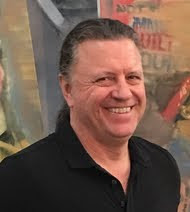Love Songs to the City
Turn the nightly news on today, or scan the latest headlines on your iPhone, and it would seem that the world grows uglier each day. Eleven years ago, I wrote about my search for images of peace. I hearken back to those thoughts prompted by a memory of a time in Perth, Australia reading an art review concerning an exhibition about peace. Most of the images in the show were anti-war but few if any were really about the idea of peace. The title of the review was "how do you paint peace." Prompted by these ongoing concerns, I have been creating a new series of paintings using ideas of New Urbanism - Los Angeles in particular with peace as a subtext. What the amazing writer, actor, and teacher Claudette Sutherland, in my studio yesterday evening, called "Love Songs to the City."
%2B30%22x24%22%2Boil%2Bon%2Blinen%2B2015.jpg) |
Gregg Chadwick Third L.A. (for Christopher Hawthorne) 30"x24" oil on linen 2015 |
 |
Gregg Chadwick Thursday's Child 8"x6" oil on panel 2015 |
"The First Los Angeles, stretching roughly from the city’s first population boom in the 1880s through 1940, a city growing at an exponential pace built a major transit network and innovative civic architecture.
In the Second Los Angeles, covering the period from 1940 to the turn of the millennium, we pursued a hugely ambitious experiment in building suburbia –- a privatized, car-dominated landscape –- at a metropolitan scale.
Now we are on the cusp of a new era. In a series of six public events, some on the Occidental College campus and others elsewhere, the Third Los Angeles Project will explore and explain this new city. "
The Dalai Lama makes it clear in Beyond Religion: Ethics for a Whole World that an individual does not have to be religious to be ethical. Love and compassion are necessities for living. Compassion expresses deep sensitivity to the sufferings of others and a fierce drive to help alleviate those sufferings. Compassion is also the realization that we - human beings, animals, and the earth itself - are all interconnected.
How would you paint peace?
Labels: Christopher Hawthorne, Compassion, dalai lama, gregg chadwick, how do you paint peace?, love songs to the city, Michael Shermer, Steven Pinker, The Enlightenment, Third Los Angeles




0 Comments:
Post a Comment
<< Home